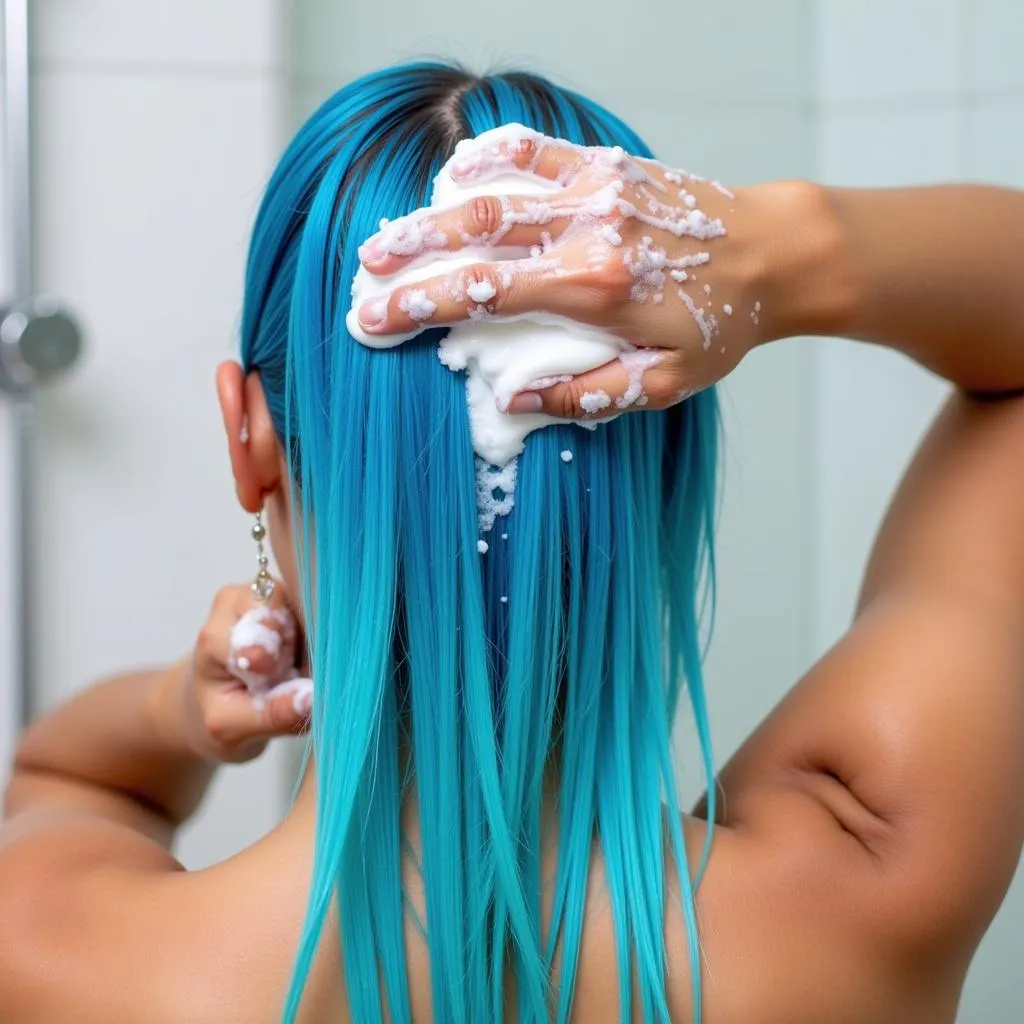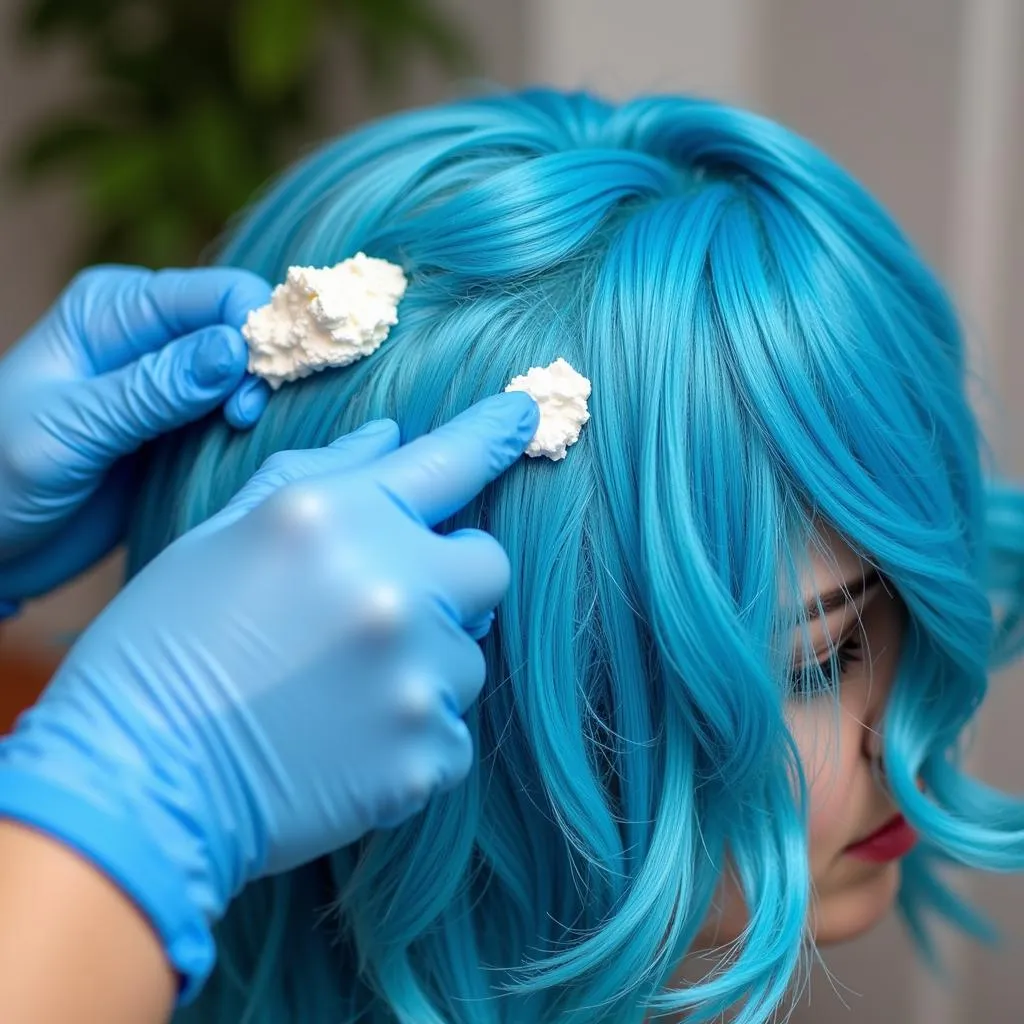So, you experimented with blue hair dye, and while the initial thrill was real, now you’re ready to move on. Whether you’re facing a dye job gone wrong or simply craving a change, removing blue hair color can feel like navigating a maze of conflicting advice. Don’t worry, you’re not alone! This comprehensive guide will equip you with the knowledge and tools to safely and effectively remove blue hair dye and transition to your desired hair color.
Understanding Blue Hair Dye and Removal
Before we dive into the nitty-gritty of blue hair color removal, let’s understand why this particular shade can be stubborn. Blue hair dye, especially darker shades, contain larger color molecules that penetrate the hair shaft deeply, making them harder to lift than other colors.
Factors Affecting Blue Hair Dye Removal:
- Hair Porosity: Porous hair tends to absorb and hold onto color more intensely, making removal trickier.
- Dye Type: Semi-permanent dyes are generally easier to remove than permanent ones.
- Time Elapsed: The longer the dye has been in your hair, the more challenging it can be to remove completely.
- Hair History: Previous chemical treatments like bleaching or perming can impact the effectiveness of color removal methods.
 Woman washing blue hair with clarifying shampoo
Woman washing blue hair with clarifying shampoo
Methods to Remove Blue Hair Color
Fortunately, several methods can help you say goodbye to unwanted blue hues. Remember, patience and a gentle approach are key to minimizing damage and achieving your desired results.
1. Clarifying Shampoo: The Gentle Approach
For a milder approach, especially if you have semi-permanent dye, a clarifying shampoo can be your first line of defense.
- How it works: Clarifying shampoos contain stronger cleansing agents that can help lift and fade artificial color molecules from the hair cuticle.
- How to use: Use the clarifying shampoo 2-3 times a week, leaving it on for a few minutes before rinsing.
- Things to note: While effective, this method might take several washes to show noticeable results.
2. Color Remover: A Targeted Solution
Color removers, unlike bleach, are designed to shrink the dye molecules, making them easier to rinse out. They are generally gentler on the hair than bleach but might not completely eliminate the color in one go.
- How to use: Follow the instructions on the product carefully, as application times and techniques vary.
- Things to note: Perform a strand test beforehand to gauge the product’s effectiveness and potential impact on your hair.
 Close-up of hands applying vitamin C paste to blue hair
Close-up of hands applying vitamin C paste to blue hair
3. DIY Vitamin C Treatment: A Natural Option
Looking for a more natural approach? Vitamin C, when mixed with shampoo, can help oxidize and break down hair dye molecules.
- How it works: Crush vitamin C tablets and mix them with your regular shampoo to create a paste. Apply this mixture to your hair and leave it on for 30-60 minutes before rinsing.
- Things to note: While generally safe, it’s essential to do a patch test to check for any allergic reactions.
4. Baking Soda Paste: Another Natural Ally
Baking soda, a common household ingredient, can also aid in lifting blue hair dye due to its mild abrasive properties.
- How it works: Create a paste by mixing baking soda with water and apply it to your hair. Leave it on for 15-20 minutes before rinsing.
- Things to note: This method can be drying, so follow up with a deep conditioning treatment.
5. Seeking Professional Help: When In Doubt
If you’re dealing with stubborn blue dye, especially permanent color, or have concerns about potential damage, seeking professional help is always the safest bet. How long does a color correction take? It depends on the current state of your hair and the desired outcome.
- Why it matters: Hair professionals have the expertise and tools to safely remove color while minimizing damage. They can also assess your hair condition and recommend the best course of action.
“Remember, every head of hair is unique, and what works for one person might not work for another,” says celebrity hairstylist, Emily Carter. “Understanding your hair type and dye history is crucial when choosing a removal method.”
Post-Removal Care: Nourishing Your Hair
After successfully removing the blue hue, it’s time to pamper your hair and restore its health.
- Deep Condition: Use a deep conditioner to replenish moisture lost during the color removal process.
- Hair Mask: Indulge in a weekly hair mask to provide intense nourishment and repair.
- Avoid Heat Styling: Give your hair a break from heat styling to prevent further damage.
 A woman smiling with healthy, shiny hair after removing blue dye
A woman smiling with healthy, shiny hair after removing blue dye
Conclusion
Removing blue hair color doesn’t have to be a daunting task. By understanding the factors involved, choosing the right removal method, and prioritizing post-treatment care, you can successfully transition to your desired hair color while maintaining healthy and vibrant locks. Remember, patience is key, and seeking professional help is always an option if you’re unsure about any step of the process.
FAQs about Removing Blue Hair Color
1. Can I dye my hair immediately after removing blue hair dye?
It’s best to wait at least a week or two after removing blue hair dye before dyeing it again. This allows your hair cuticles to close and prevents further damage or uneven color absorption.
2. Will removing blue hair dye damage my hair?
The level of damage depends on the method used and the current condition of your hair. Using harsh chemicals repeatedly can lead to dryness and breakage. Always opt for gentler methods and prioritize deep conditioning treatments.
3. Can I remove blue hair dye at home?
Yes, several DIY methods can help remove blue hair dye at home. However, always perform a strand test first and proceed with caution, especially if using strong chemicals.
4. What if the blue dye doesn’t come out completely?
If DIY methods don’t yield satisfactory results, it’s best to consult a hair professional. They have the expertise and products to address stubborn dye and minimize damage.
5. How can I prevent my hair from turning blue again?
If you’re prone to blue tones, consider using color-safe shampoos and conditioners designed to neutralize unwanted hues. Regular toning treatments can also help maintain your desired hair color.
Looking for more tips on hair color? Check out our guides on how to do color analysis at home and how to find your perfect hair color.
Ready to transform your hair? Contact Color Box Hanoi at 0373298888, email us at [email protected], or visit us at 86 Cau Giay, Hanoi. Our team of experts is available 24/7 to help you achieve your dream hair goals!

